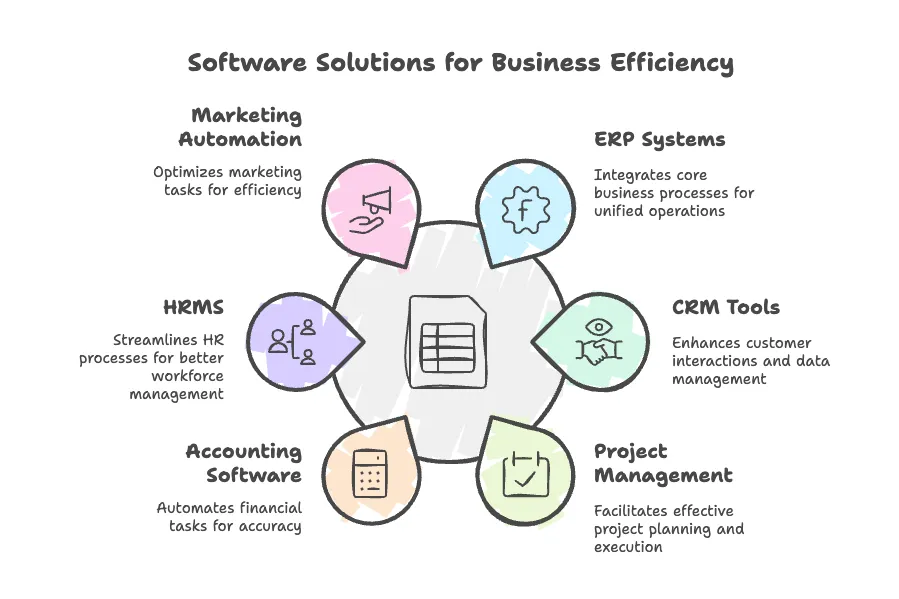
Unlocking Efficiency: The Ultimate Guide to Software for Business
Unlocking Efficiency: The Ultimate Guide to Software for Business
In the ever-evolving landscape of modern business, the integration of software solutions has become indispensable. As companies strive to enhance productivity and streamline operations, the role of business software is more crucial than ever. From automating mundane tasks to optimizing complex workflows, the right software can transform your business operations, allowing you to focus on growth and innovation.
The digital transformation journey is not just about adopting new technologies; it is about rethinking how your organization operates and delivers value to customers. This guide aims to provide a comprehensive overview of the various software solutions available, their benefits, and how to effectively implement them in your business strategy.
Understanding Business Software
Business software encompasses a wide range of applications designed to assist in various business processes. These tools are crafted to improve efficiency, reduce errors, and provide insights that drive strategic decisions. Whether you're managing a small startup or a large corporation, understanding the types of software available can help you choose the best fit for your needs. The landscape of business software is vast and varied, with solutions tailored to meet the unique demands of different industries.
From retail to healthcare, the right software can help businesses navigate challenges, enhance customer experiences, and ultimately drive profitability. As technology continues to advance, the capabilities of business software are expanding, offering even more opportunities for organizations to leverage these tools for competitive advantage.

Types of Business Software
There are several categories of business software, each serving distinct functions. Common types include:
Enterprise Resource Planning (ERP): Integrates core business processes such as finance, HR, and supply chain management, providing a unified view of operations and facilitating better decision-making.
Customer Relationship Management (CRM): Manages interactions with current and potential customers, enhancing customer service and sales through improved data management and communication strategies.
Project Management Tools: Facilitates planning, executing, and monitoring projects to ensure timely completion, allowing teams to collaborate effectively and stay on track with deadlines.
Accounting Software: Automates financial transactions, reporting, and compliance tasks, ensuring accuracy in financial records and simplifying tax preparation.
Human Resource Management Systems (HRMS): Streamlines HR processes such as recruitment, onboarding, payroll, and performance management, helping organizations manage their workforce more effectively.
Marketing Automation Tools: Automates marketing tasks such as email campaigns, social media posting, and lead generation, enabling businesses to reach their target audience more efficiently.
Collaboration Software: Enhances communication and teamwork among employees, often featuring tools for file sharing, video conferencing, and real-time messaging.
Benefits of Implementing Business Software
Implementing the right software can yield numerous benefits, including:
Increased Efficiency: Automating repetitive tasks frees up time for strategic activities, allowing employees to focus on higher-value work that drives business growth.
Improved Accuracy: Reduces human error in data entry and processing, leading to more reliable information and better decision-making.
Enhanced Collaboration: Facilitates communication and teamwork across departments, breaking down silos and fostering a culture of collaboration.
Data-Driven Insights: Provides analytics and reporting tools for informed decision-making, enabling businesses to identify trends, measure performance, and adjust strategies accordingly.
Cost Savings: By streamlining processes and reducing manual labor, businesses can lower operational costs and allocate resources more effectively.
Scalability: Many software solutions are designed to grow with your business, allowing you to add features and users as needed without significant disruptions.
Enhanced Customer Experience: With better data management and communication tools, businesses can provide more personalized and responsive service to their customers, leading to increased satisfaction and loyalty.
Choosing the Right Software for Your Business
Selecting the appropriate software requires a thorough understanding of your business needs and objectives. The right choice can significantly impact your operations and bottom line. It is essential to approach this decision with a clear strategy, as the software you choose will play a pivotal role in shaping your business processes and overall efficiency.
Engaging stakeholders from various departments during the selection process can provide valuable insights into the specific needs and challenges faced by different teams, ensuring that the chosen software aligns with the broader organizational goals.

Assessing Your Business Needs
Begin by identifying the specific challenges and goals of your business. Consider the following:
Identify Pain Points: What processes are currently inefficient or error-prone? Conducting a thorough analysis of your existing workflows can help pinpoint areas that require improvement.
Define Objectives: What do you hope to achieve with new software? Increased sales, better customer service, or streamlined operations? Setting clear, measurable goals will guide your software selection process.
Budget Considerations: Determine how much you are willing to invest in software solutions. Keep in mind that while some software may have a higher upfront cost, the long-term savings and benefits can outweigh the initial investment.
Future Growth: Consider your business's growth trajectory and how the software can accommodate future needs. Choosing a solution that can scale with your business will save you from having to switch systems down the line.
Evaluating Software Options
Once you've defined your needs, evaluate potential software solutions based on:
Features and Functionality: Does the software offer the tools you need? Create a checklist of must-have features to help narrow down your options.
Scalability: Can the software grow with your business? Look for solutions that offer flexible pricing plans and the ability to add users or features as needed.
Integration Capabilities: Will it work seamlessly with your existing systems? Ensuring compatibility with your current software stack can save time and reduce disruptions during implementation.
User Experience: Is the software intuitive and easy to use? A user-friendly interface can significantly reduce the learning curve and improve adoption rates among employees.
Vendor Reputation: Research the software provider's reputation in the market. Look for reviews, case studies, and testimonials from other businesses to gauge their reliability and customer support.
Trial Periods: Take advantage of free trials or demos to test the software in real-world scenarios. This hands-on experience can provide valuable insights into how well the software meets your needs.
Implementing Business Software
Successful implementation of business software requires careful planning and execution. This ensures that the transition is smooth and that the software delivers the expected benefits. A well-structured implementation plan can help mitigate risks and address potential challenges before they arise.
Engaging employees early in the process and communicating the benefits of the new software can foster a positive attitude towards the change, making it easier for teams to adapt to new workflows and processes.

Planning the Implementation
Develop a comprehensive plan that includes:
Timeline: Set realistic deadlines for each phase of the implementation. Break the project into manageable stages to ensure that progress is measurable and achievable.
Resource Allocation: Assign team members to oversee the implementation process. Designate a project manager to coordinate efforts and ensure that everyone is aligned with the project goals.
Training and Support: Provide training sessions to ensure all users are comfortable with the new system. Consider offering ongoing support and resources, such as user manuals and FAQs, to assist employees as they adapt to the new software.
Change Management: Develop a change management strategy to address any resistance to the new software. Communicate the benefits clearly and involve employees in the process to foster buy-in and enthusiasm.
Monitoring and Optimization
After implementation, continuously monitor the software's performance and make necessary adjustments. Consider:
Feedback Collection: Gather input from users to identify areas for improvement. Regularly check in with employees to understand their experiences and any challenges they may face.
Performance Metrics: Track key performance indicators to measure the software's impact. Establish benchmarks to evaluate success and identify opportunities for further optimization.
Regular Updates: Keep the software updated to leverage new features and security enhancements. Staying current with software updates can help protect your business from vulnerabilities and ensure that you are utilizing the latest capabilities.
Continuous Training: Offer ongoing training sessions to keep employees informed about new features and best practices. This can help maximize the software's potential and ensure that users are fully equipped to utilize its capabilities.
Future Trends in Business Software
The landscape of business software is constantly evolving, with new trends emerging that promise to further enhance business operations. Staying informed about these trends can help you maintain a competitive edge. As technology advances, businesses must adapt to new tools and methodologies to remain relevant in their industries. Embracing innovation and being open to change can position your organization for success in an increasingly digital world.
Artificial Intelligence and Machine Learning
AI and machine learning are increasingly being integrated into business software, offering capabilities such as predictive analytics, automated customer service, and personalized marketing strategies. These technologies can analyze vast amounts of data to identify patterns and trends, enabling businesses to make more informed decisions.
For instance, AI-driven chatbots can provide instant support to customers, improving response times and enhancing the overall customer experience. Additionally, machine learning algorithms can help businesses forecast sales, optimize inventory levels, and tailor marketing campaigns to specific customer segments, ultimately driving revenue growth.
Cloud-Based Solutions
Cloud computing continues to revolutionize business software, providing scalable, flexible, and cost-effective solutions that can be accessed from anywhere. This shift to the cloud allows businesses to reduce their reliance on on-premises infrastructure, lowering maintenance costs and increasing accessibility for remote teams.
Cloud-based software also enables real-time collaboration, allowing employees to work together seamlessly, regardless of their physical location. As more businesses embrace remote work, the demand for cloud solutions is expected to grow, making it essential for organizations to consider cloud-based options when selecting software.
Cybersecurity Enhancements
As cyber threats become more sophisticated, business software is incorporating advanced security features to protect sensitive data and ensure compliance with regulations. With the increasing frequency of data breaches and cyberattacks, businesses must prioritize cybersecurity in their software selection process.
This includes evaluating the security measures implemented by software providers, such as encryption, multi-factor authentication, and regular security audits. Additionally, organizations should invest in employee training to raise awareness about cybersecurity best practices, ensuring that all team members are equipped to recognize and respond to potential threats.
Integration of Internet of Things (IoT)
The integration of IoT devices into business software is another trend that is gaining traction. IoT technology allows businesses to collect real-time data from connected devices, providing valuable insights into operations and customer behavior. For example, manufacturers can use IoT sensors to monitor equipment performance and predict maintenance needs, reducing downtime and improving efficiency.
Retailers can track customer interactions with smart devices, enabling them to personalize marketing efforts and enhance the shopping experience. As IoT technology continues to evolve, businesses that leverage these capabilities will be better positioned to optimize their operations and deliver exceptional value to customers.
Conclusion
Investing in the right software for your business is a strategic decision that can drive efficiency, innovation, and growth. By understanding your needs, evaluating options, and staying informed about industry trends, you can leverage software to achieve your business goals and maintain a competitive advantage in the marketplace.
The journey towards digital transformation is ongoing, and businesses must remain agile and adaptable to thrive in an ever-changing environment. Embracing new technologies and fostering a culture of continuous improvement will empower your organization to navigate challenges and seize opportunities in the digital age.

Ready to unlock the full potential of your business with a single, powerful software solution?
Look no further than Pancake Pixels, the #1 choice for entrepreneurs and service providers. Our all-in-one platform replaces your entire tech stack, offering customer management, scheduling, payments, automated workflows, and much more.
With Pancake Pixels, you can streamline your operations, boost customer engagement, and make your business run smoother. From seamless communication to insightful reporting, our exciting features are designed just for you. Simplify your tech stack and elevate your business across all fronts.
Whether you're a service provider, e-commerce store, educational institution, nonprofit, or digital agency, Pancake Pixels is tailored to meet your needs. Don't miss this opportunity to transform your business. Join FREE today and start your journey to success with Pancake Pixels!
